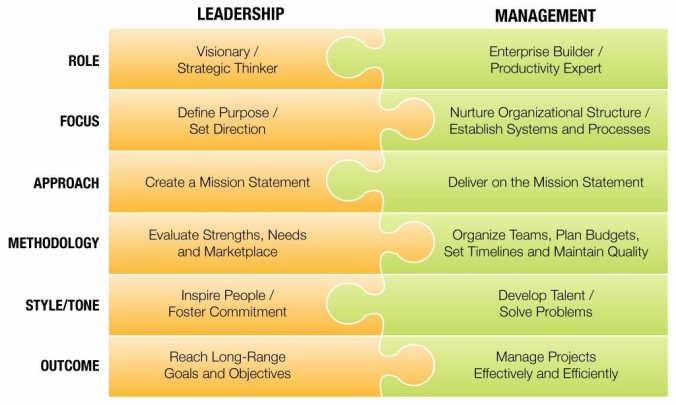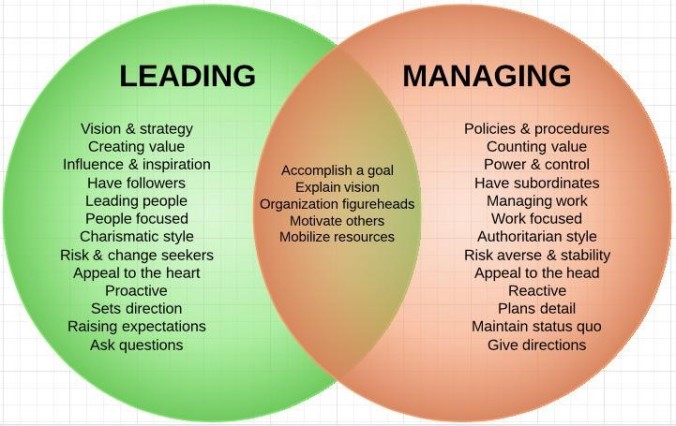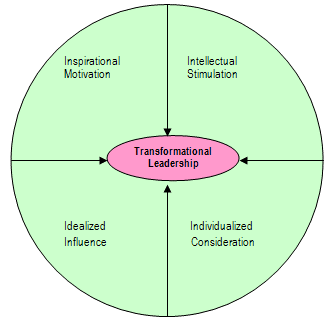Most
Effective Leadership & Management Styles & Approaches
According to Yukl (2010:26), leadership means influencing others in
understanding a task, agreeing on action needed and guiding the method. It is
also facilitating individual and group efforts to achieve common goals.
Meanwhile Peter Drucker express management as a function for people with given
social status and authority to discharge, discipline, and control others to
achieve a given task (Mullins and Christy 2013:421).
Leadership and management are different in field but they share common
goals (Kotterman 2006).
The differences of
leaders are that they can promote change, new strategies, and able to convince
people to get their commitment. Managers on the other hand, promotes stability,
exercise authority and they get things done according to the experienced
practices (Algahtani 2014).
For instance, on the first day as
Ford’s CEO, Alan Mulally exhibits his leadership when he ignored one of his top
executives who practices management authority, and directly meet with the
front-line workers to understand their problem (George 2016).
Another distinctive difference between leadership and management is well
expressed in Figure 1 below.

Figure 1: Leadership vs. Management
(Source: http://www.championsforgrowth.com/leadership-and-management-complimentary-partners-forever-connected/)
According to Dr. Ali Algahtani (2014),
the main similarities between these two roles are working
with individuals, then to control and influence them. Sometimes, a successful
manager has to work as leader.
Further similarities showed by Tahir (2015) in Figure 2 below.

Figure 2: Leadership vs. Management
(Source: https://www.researchgate.net/post/What_is_the_difference_between_management_and_leadership)
One of the effective leadership approach is the Transformational Leadership Model. According to Yukl
(2010:263-280), transformational leaders transmit charismatic personality and
inspirational values, provides motivations, and inspire followers to
institution reforms. The four factors that a transformational leader should
have are as Figure 3 below.

Figure 3: Transformational Behaviour
(Source: https://managementstudyguide.com/transformational-leadership.htm)
The advantages of
transformational leaders are their ability to evaluate a company’s condition
and create effective vision for growth and development. They are also capable
in motivating their subordinates and aligns them to work towards the same
vision (Kokemuller 2016).
Conversely, the main limitation of this leadership style is that
tendency to rely on emotion and passion that overlooked the truth and reality.
Transformational leaders may exhibit illogical reasoning in facing the fact
about the company’s problems (Kokemuller 2016).
Examples:
One of the successful transformational leaders is the aforementioned
Alan Mulally, whom turnaround Ford Motors when the company was at the brink of
bankruptcy in 2006. Apart from Ford’s financial problems, Alan had to transform
the company’s severe management cultural problems. Through his “Positive
Leadership” values and effective influence, Alan breaks down the “turf”
mentality barriers between company segments, instill team work culture,
incorporate colour-coding system, create “One Ford” strategy and finally return
Ford’s original mission; “produce quality cars for the masses” (Lorsch and
McTague 2016). Prior to Alan’s retirement in 2014, he successfully transformed
Ford’s corporate culture, survived 2009 financial crisis without bailout,
and reported profit of $7.2 billion in 2013 (Leggett 2014).
Alan Mulally’s positive and humble leadership would be how I like to be
led. As how he has managed in Ford Motors, his leadership style promotes
strength, provide job fulfillment, and most importantly a supportive
environment. For instance, instead of firing Mark Fields who reported launching
delay for new vehicle, he praised Mark for having great visibility and work out
solution as a team (George 2016).
Another example of transformational leadership is shown from the late
Steve Jobs. He is known for his futuristic visions in personal computers and
created transformational products like iPod, iPad and iPhone that significantly
increased Apple’s stock from $4 to $400, and subsequently led Apple as world’s
most valuable company in 2012 (Galloway 2013). Jobs maintained the strong
teamwork culture and encourages strong opinion arguments to make better
judgment. He also exhibits utmost passion, creativity and visionary of a
transformational leader (Tetzeli 2015).
Still, there is other part of Steve Jobs that was not favoured by many,
particularly his autocratic style of leadership. For instance, there were times
when he heavily criticise his subordinates, creating loud heated disrespectful
arguments, insults and resulted in abuse in management. Because of him, Apple
is perceived as “mean” and a very secretive company (Coursey 2011).
In conclusion, I would agree to there
is no single ideal or best approach in management and leadership that can be
applicable to all organisations (CMI 2013). This is because managers and
leaders need to understand their own organisation clearly and try to modify
their management and leadership style to suit subordinates’ limitations, then
improvise to obtain best results. This simply means an effective manager needs
to know when to apply management theories as well as leadership theories to
help subordinates achieving best performance every time.
Being A Good Leader
All educators take on leadership roles. Teachers are the leaders of their classrooms. Principals are the leaders of their schools. Every educator and administrator plays a part in leading tomorrow’s future. How inspiring is that? Together, no matter what your role, you are all making a difference in the lives of your students.
Want to be sure you’re being a good leader? Here are five of the most important characteristics any effective educational leader should possess and demonstrate on a daily basis.
1. Self-aware
A good educational leader needs a solid understanding of oneself and should also have confidence. When you believe in yourself, you can accomplish so much more. Have confidence in the decisions you make, don’t be nervous, and don’t be afraid of what others may think. Plan how you’ll start each and every day in ways that will lead your students, school, and colleagues in the right direction to achieve their goals.
2. Excellent communication skills
You can’t lead a group of people if you don’t speak with others! The best educational leaders are excellent communicators and know how to reach a variety of people in many different ways. For instance, a principal might have one-on-one chats with teachers each week and also send out a daily email update. This way, the principal takes the time to communicate in-person but also makes communication convenient by emailing the teachers as well. No matter what your job title is at your school, make sure you’re constantly communicating with your colleagues, students, and others.
3. Resourceful
To be an effective leader, you need to be resourceful and open to new ideas. Especially during tough economic times, technology helps to change classrooms, and you need to be open to new ideas that will improve the way students absorb and retain information. You also need to know how to use the resources you have to the best of your ability—if you aren’t sure, ask someone in the know. Take an online course. Get the answers you need; others around you will benefit greatly from this type of leadership mentality.
4. Lead by example
The best leaders in the educational system make it a point to lead by example, and not simply by words. It’s easy to spell out rules and dictate them from an ivory tower, but this type of leadership will not have a large impact in your school. As an educator, you have so much influence on students. If you want students to speak kindly to one another in the hallways, you must always speak kindly, too. If you want your students to show respect, show them what that means. This method is effective and powerful, and helps you teach students skills they will need for the rest of their lives.
5. Power of teaching and learning
Perhaps the most important trait of being an educational leader is believing in your students and the power of education. If you don’t believe in your students or your colleagues, then everyone is doomed for failure. It’s vital to believe in what your school is trying to accomplish each and every day, and to convey your enthusiasm for change, your own motivation to make things better, and your confidence in those around you. Your words and actions directly impact morale—show others your passion for education, and they’ll feel it too.
There are obviously so many different characteristics and traits of a good leader, but these are a great place to start if you’re stepping up to more of a leadership role in your school—whether that’s in your classroom, on a sports team you coach, or within your district. Show ’em what you got.
If leadership is in the stars for you, you’ll love what our online MEd in Educational Leadership has to offer for working professionals.

 Home
Home









No comments:
Post a Comment